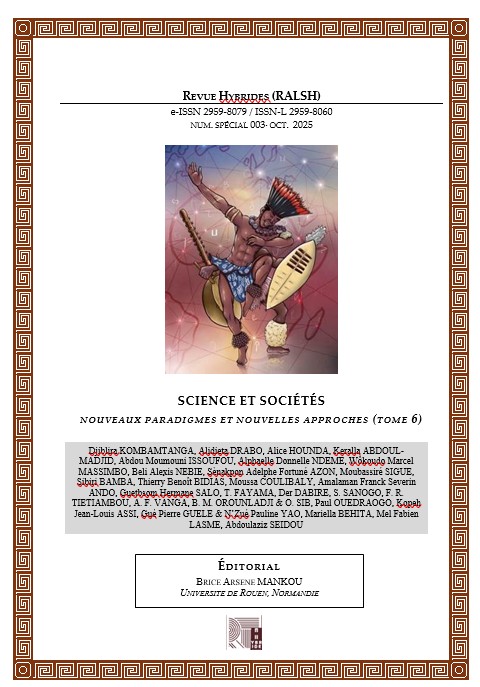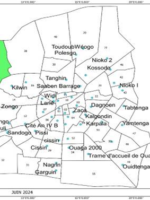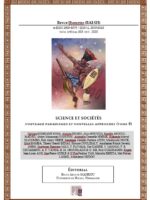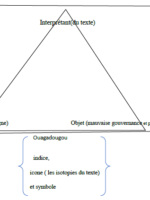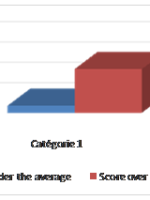Revue Hybrides (RALSH)
e-ISSN 2959-8079 / ISSN-L 2959-8060
Num. spécial 003, Oct. 2025
Defying social norms: A critical race theory analysis of interracial marriage challenges in Danzy Senna’s Caucasia (1998)
Défier les normes sociales : Une analyse, à la lumière de la théorie critique de la race, des défis liés au mariage interracial dans Caucasia de Danzy Senna (1998)
Université d’Abomey-Calavi, Bénin, Laboratoire GRAD, Bénin
Email : fortuneazon@gmail.com
Orcid id : https://orcid.org/0000-0002-2700-6870
Abstract: This paper explores the enduring social challenges faced by interracial marriages in the United States, using Danzy Senna’s Caucasia (1998) as case study. Despite the US Supreme Court’s decision Loving v. Virginia (1967) that removed the legal barriers to interracial unions, Black-White marriages, particularly, still confront persistent social rejection, familial resistance, and complex identity formation issues with multiracial children. Applying critical race theory, this paper aims to analyse how the entrenched racial boundaries and social attitudes that multiracial marriage partners have tried to defy, crop up to complicate personal relationships and gradually undermine family dynamics. Using the backdrop of the second-half of the 1970s which is the setting of Caucasia (1998) for its analysis, it highlights Sandy and Deck’s union as exemplifying the said challenges faced by families with different racial, cultural, and political backgrounds, which ultimately contribute to marital instability and divorce. It furthermore reads in their children Birdie and Cole’s contrasting experiences shaped by their varying skin tones, the American society’s understanding of, and attitude to, multiraciality. The expected output of this analysis of trespassing social norms and complex identity formation is to draw inferences to illuminate the present race dynamics in multiracial families: the intersection of race, love, family, and identity, and to conclude that the American society remains today reluctant to moving beyond race-based divisions toward a color-blind society.
Keywords: Black-White marriages, Racism, Discrimination, Identity.
Résumé : Le présent article examine les défis sociaux persistants auxquels sont confrontés les mariages interraciaux, aux Etats-Unis, prenant Caucasia (1998) de Danzy Senna comme étude de cas. Malgré l’arrêt de la cour suprême des Etats-Unis Loving vs Virginia (1967) ayant levé les barrières légales aux unions interraciales, les marriages entre Noirs et Blancs en particulier continuent de faire face à un rejet social tenace, à la résistance familiale et à des problématiques complexes de formation identitaire chez les enfants d’ascendance mixte. Adoptant le critical race theory l’article analyse la façon dont les barrières raciales érigées et les attitudes sociales ancrées que les époux des mariages mixtes ont tenté de défier ressurgissent pour compliquer les relations personnelles et perturber la dynamique familiale. Utilisant l’arrière-plan de la seconde moitié des années 1970 qui sert de cadre à l’action de Caucasia (1998) pour son analyse, l’article met en lumière l’union de Sandy et de Deck dans Caucasia (1998) comme illustration de ces défis rencontrés par les familles issues d’origines raciales, culturelles et politiques différentes, facteur qui contribue in fine à l’instabilité conjugale et au divorce. Il lit en outre dans les expériences contrastées de leurs enfants Birdie et Cole, façonnées par leurs teints de peau variés, la compréhension et l’attitude de la société américaine envers la multiracialité. Le résultat escompté de cette analyse de la violation des normes sociales et de la formation identitaire complexe, c’est de tirer des inférences pour éclairer les dynamiques raciales actuelles dans les familles métisses : l’intersection de la race, de l’amour, de la famille et de l’identité, pour conclure que la société américaine reste aujourd’hui réticente à dépasser dépasser les divisions raciales afin d’évoluer vers une société indifférente à la race.
Mots-clé: Mariages Blancs-Noirs, Racisme, Discrimination, Identité.
References
Bennett, B. (2020). The vanishing half. Riverhead Books.
BetterHelp. (2025). History of interracial marriage. https://www.betterhelp.com/advice/marriage/history-of-interracial-marriage/
Brown, W. W. (1853). Clotel; or, The president’s daughter. Published by the author.
Cardwell, M. (2021). Examining interracial family narratives using critical multiracial theory. Review of Communication, 21(3), 206–222. https://doi.org/10.1080/15358593.2021.1964098
Choi, K. H. (2021). Family relations after interracial marriage. Psychology Today. https://www.psychologytoday.com/za/blog/social-fabric/202103/family-relations-after-interracial-marriage
Delgado, R., & Stefancic, J. (2013). Critical race theory: The cutting edge (3rd ed.). Temple University Press.
Delgado, R., & Stefancic, J. (2017). Critical race theory: An introduction. New York University Press.
Durrow, H. (2010). The girl who fell from the sky. Algonquin Books.
Flores, R. D. (2020). “A little more ghetto, a little less cultured”: Are there racial stereotypes about interracial daters in the United States? Sociology of Race and Ethnicity, 6(2), 269–286. https://doi.org/10.1177/2332649219835851
Harper, F. E. W. (1892). Iola Leroy; or, Shadows uplifted. Donohue and Henneberry.
Harris, C. I. (1993). Whiteness as Property. Harvard Law Review, 106(8), 1707-1791.
Kalmijn, M. (1993). Trends in Black/White intermarriage. Social forces, 72(1), 119-146. https://doi.org/10.2307/2579670
Larsen, N. (1929). Passing. Knopf.
Morrison, T. (2008). A mercy. Knopf.
Pew Research Center. (2017). Trends and patterns in intermarriage. https://www.pewresearch.org/social-trends/2017/05/18/1-trends-and-patterns-in-intermarriage/
Robinson, M. C. (2017). Black and White biracial marriage in the United States. The Family Journal, 25(3), 208-214. https://doi.org/10.1177/1066480717711117
Senna, D. (1998). Caucasia. Riverhead Books.
U.S. Census Bureau. (2022). Marriage prevalence for Black adults varies by state. https://www.census.gov/library/stories/2022/07/marriage-prevalence-for-black-adults-varies-by-state.html
Zhang, Y., & Van Hook, J. (2009). Marital dissolution among interracial couples. Journal of Marriage and Family, 71(1), 95–107. https://doi.org/10.1111/j.1741-3737.2008.00582.x

